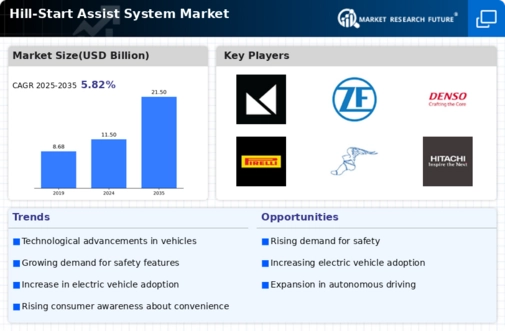Market Growth Projections
The Global Hill-Start Assist System Market Industry is projected to experience substantial growth over the next decade. With a market value expected to reach 11.5 USD Billion in 2024 and further increase to 21.5 USD Billion by 2035, the industry is poised for significant expansion. This growth is driven by various factors, including increasing vehicle safety regulations, rising demand for advanced driver assistance systems, and technological advancements in automotive engineering. The market is anticipated to grow at a CAGR of 5.82% from 2025 to 2035, reflecting the ongoing evolution of consumer preferences and regulatory landscapes.
Increasing Vehicle Safety Regulations
The Global Hill-Start Assist System Market Industry is experiencing growth due to the rising emphasis on vehicle safety regulations. Governments worldwide are implementing stricter safety standards, compelling manufacturers to integrate advanced safety features such as hill-start assist systems. This system aids drivers in preventing roll-back on inclines, thereby enhancing overall vehicle safety. As a result, the market is projected to reach 11.5 USD Billion in 2024, reflecting the industry's response to regulatory pressures. The integration of such systems not only meets compliance requirements but also attracts safety-conscious consumers, further driving market expansion.
Growing Urbanization and Traffic Congestion
The Global Hill-Start Assist System Market Industry is also influenced by the growing urbanization and traffic congestion in major cities. As urban areas expand, the number of vehicles on the road increases, leading to more frequent encounters with hilly terrains and steep inclines. Hill-start assist systems provide a practical solution for drivers navigating these challenging conditions, reducing the risk of accidents. This trend is likely to drive demand for such systems, as urban drivers seek vehicles equipped with features that enhance safety and ease of use. The market's growth is expected to align with urbanization trends, reflecting the need for advanced driving aids.
Rising Demand for Advanced Driver Assistance Systems
The Global Hill-Start Assist System Market Industry is significantly influenced by the increasing demand for advanced driver assistance systems (ADAS). Consumers are increasingly seeking vehicles equipped with technologies that enhance driving comfort and safety. Hill-start assist systems, which prevent vehicles from rolling backward on slopes, are becoming a standard feature in many new models. This trend is expected to contribute to the market's growth, with projections indicating a rise to 21.5 USD Billion by 2035. As automakers strive to meet consumer expectations and regulatory requirements, the integration of hill-start assist systems is likely to become more prevalent.
Technological Advancements in Automotive Engineering
The Global Hill-Start Assist System Market Industry is benefiting from rapid technological advancements in automotive engineering. Innovations in sensor technology, software algorithms, and vehicle control systems are enhancing the functionality and reliability of hill-start assist systems. These advancements allow for more precise control of braking and acceleration on inclines, improving user experience and safety. As a result, the market is expected to grow at a CAGR of 5.82% from 2025 to 2035, driven by the continuous evolution of automotive technologies. Manufacturers are increasingly investing in research and development to integrate these advanced systems into their vehicles, further propelling market growth.
Consumer Awareness and Preference for Safety Features
The Global Hill-Start Assist System Market Industry is witnessing a shift in consumer preferences towards vehicles equipped with enhanced safety features. As awareness of road safety increases, consumers are more inclined to choose vehicles that offer advanced technologies, including hill-start assist systems. This growing preference is prompting manufacturers to prioritize the integration of such systems into their vehicle designs. The market is anticipated to benefit from this trend, as consumers increasingly associate safety features with overall vehicle quality and reliability. Consequently, the demand for hill-start assist systems is likely to rise, contributing to the industry's expansion.




















Leave a Comment